It’s hard to pick one moment, Egan Bernal did not launch a coup to seize control, his was a victory of small gains, of seconds gained here and there while others faded. Whether it was at Sestola, on the sterrato or the Zoncolan, he was in charge. But the most visible demonstration of this was Stage 16 when Bernal was so far ahead of the others he could peel off his rainjacket in the cobbled streets of Cortina d’Ampezzo to let the maglia rosa brighten a damp day.
The race started in Turin with Filippo Ganna getting a home win and top billing from the Italian media who need a star, although the sight of him working with the maglia rosa on his back was an awkward sell, one day a prince, the next a worker.

Stage 2 to Novara saw Tim Merlier win and Giacomo Nizzolo second, of course. There were few opportunities for the sprinters but most were well served, Caleb Ewan the fastest but so quick he left too early with either a crash at the breakfast buffet or a cleat adjustment problem cited. Nizzolo would finally land a stage win, Elia Viviani and Fernando Gaviria struggled to seize the opportunities and Peter Sagan won a stage and the points competition although this contest never really came alive, Nizzolo quit the race and Sagan finished with fewer points than he’d taken last year when he was runner-up. Still who’ll remember the maths, the story is Sagan collecting a new jersey.

Taco van der Hoorn’s stage win set the tone for breakaways winning, an unheralded rider on a team still searching for a win, he went in the early move and rode the others off his wheel and held on for the stage win.

Stage 4 to Sestola contained a lot of subjects that would become themes for the Giro. It was cold and wet, so much that the TV coverage dropped. The breakaway stayed away and the big story was Alessandro De Marchi claiming the maglia rosa, a reward for a thousand attacks as he put it, while Joe Dombrowski took the stage. Egan Bernal was first among the GC contenders. Simon Yates and Remco Evenepoel losing 11 seconds to Bernal looked important, and it counted as double as it suggested they couldn’t respond. João Almeida fared worst, legs frozen by the cold. Two days later on the San Giacomo summit finish, another wet day with intermittent TV signals, Gino Mäder won the stage, a relaunch move for the Bahrain team who’d lost their planned GC leader Mikel Landa to a crash. Bernal was again the best of the GC contenders, aided by a team that wielded Ganna over the Apennine plateau and then deployed Jonathan Castroviejo and Dani Martinez as pacemakers on the final climb.
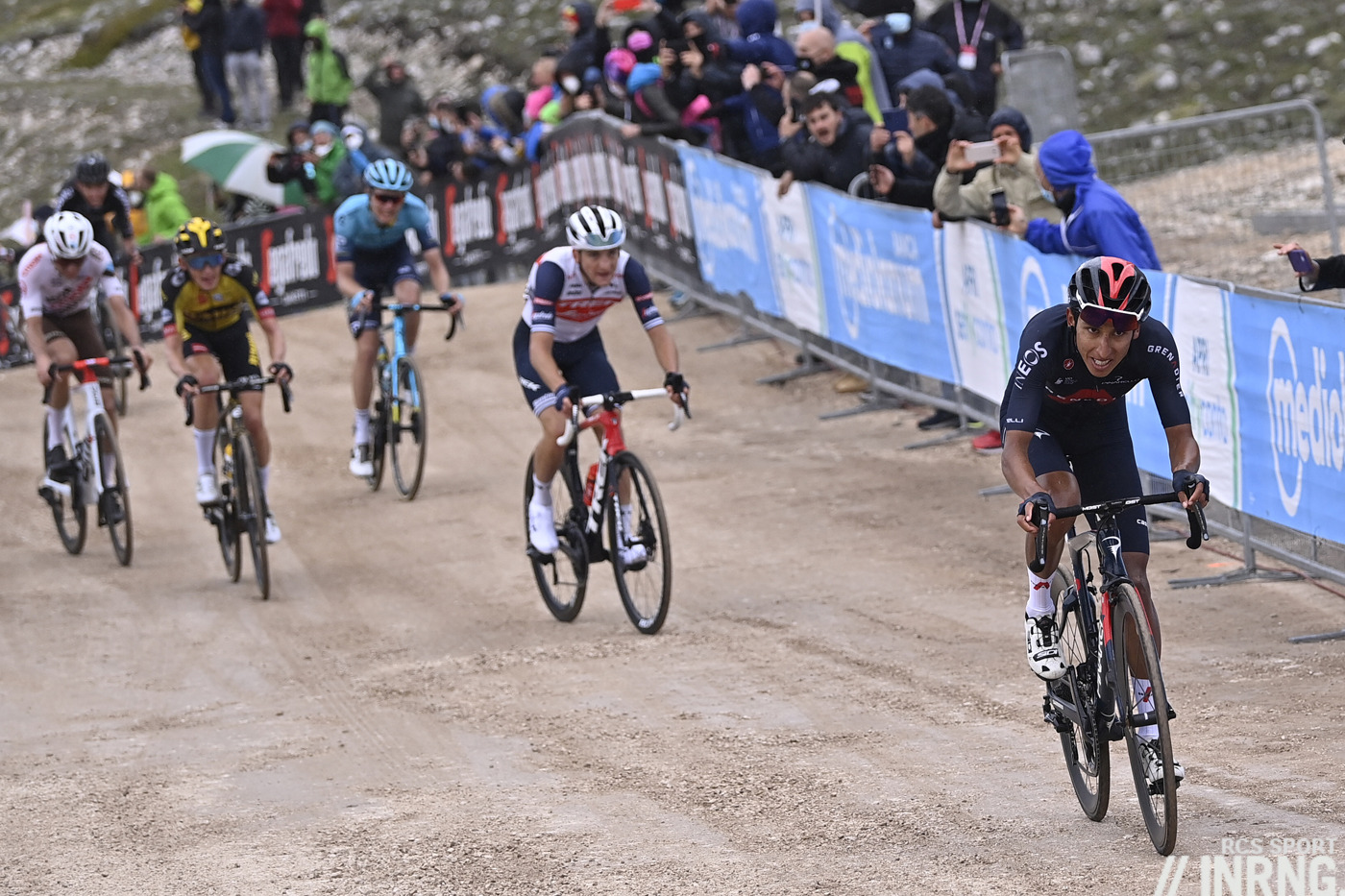
Campo Felice supplied more of the same, Bernal in the lead again only this time he’d swap his Ineos jersey for the maglia rosa and if he’d dropped his rivals to appear solo at the finish it was almost an optical illusion, most rivals were at 12 seconds, some less. But this was a symbolic moment, he could distance the rest with one kick and here he was back in the lead of a grand tour. Could anyone take the pink jersey off him? It was hard to see, the last time Ineos/Sky lost the GC lead in a grand tour…was the Vuelta as in the previous grand tour, but that’s the exception. Bernal faced his rivals, but also his spine as a threat with a chronic condition, interior and exterior challenges.
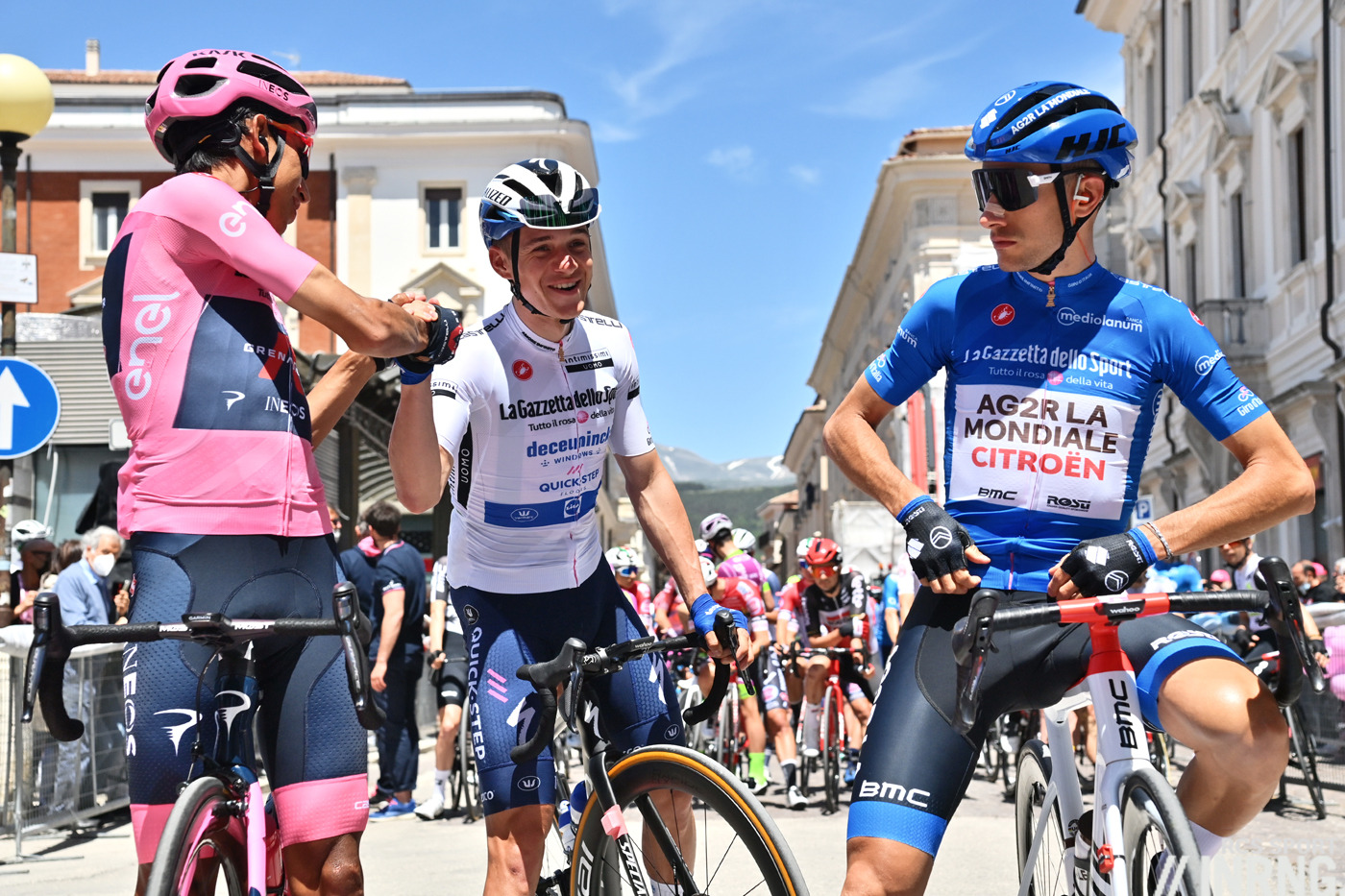
One challenger was Remco Evenepoel and on the next day’s stage to Foligno the prodigy was sprinting past Bernal for a time bonus, as if every second counted. This put him just 14 seconds short of the maglia rosa, a very solid debut for anyone, although Evenepoel is not anyone. He came with great expectations, particularly from Belgium where he’s becoming a celebrity, rather than a cyclist amid the sports pages. Perhaps maintaining this hope – rather than racing him in a warm-up event – helped bring a long-term sponsorship from Quick Step over the line? Hope or hype, this wasn’t cheap talk, he’d won every stage race he’d ridden in the previous season which made him a Giro contender although we’d yet to see how he’d handle three weeks or the high Alpine climbs. Only it was the next day’s stage to Montalcino on the gravel roads that was his undoing. He was out of position on the dash to the first sector, easy to remark but hard to resolve, rubbing rims, shoulders and elbows at 70km/h in the approach is a frantic experience. Then he was struggling on the sterrato, backing off when rivals were leaning in. Perhaps it’s all a good thing for him in the long term, the hype-meter will swing back a touch and if he’s not the new Merckx – and he never should have been – he’s already a lot more than the new Kevin Seeldraeyers. Handling problems can be improved with coaching, as a former footballer he’s not got the cultural capital that rivals collected racing bikes on and off road. And we still don’t know how he’d do in three weeks, nor on the long Alpine acscents.

The same stage to Montalcino saw Mauro Schmid take a surprise win and Egan Bernal took more time on his rivals, again measured in seconds but the arithmetic was all his way and by now only Aleksandr Vlasov was within one minute.
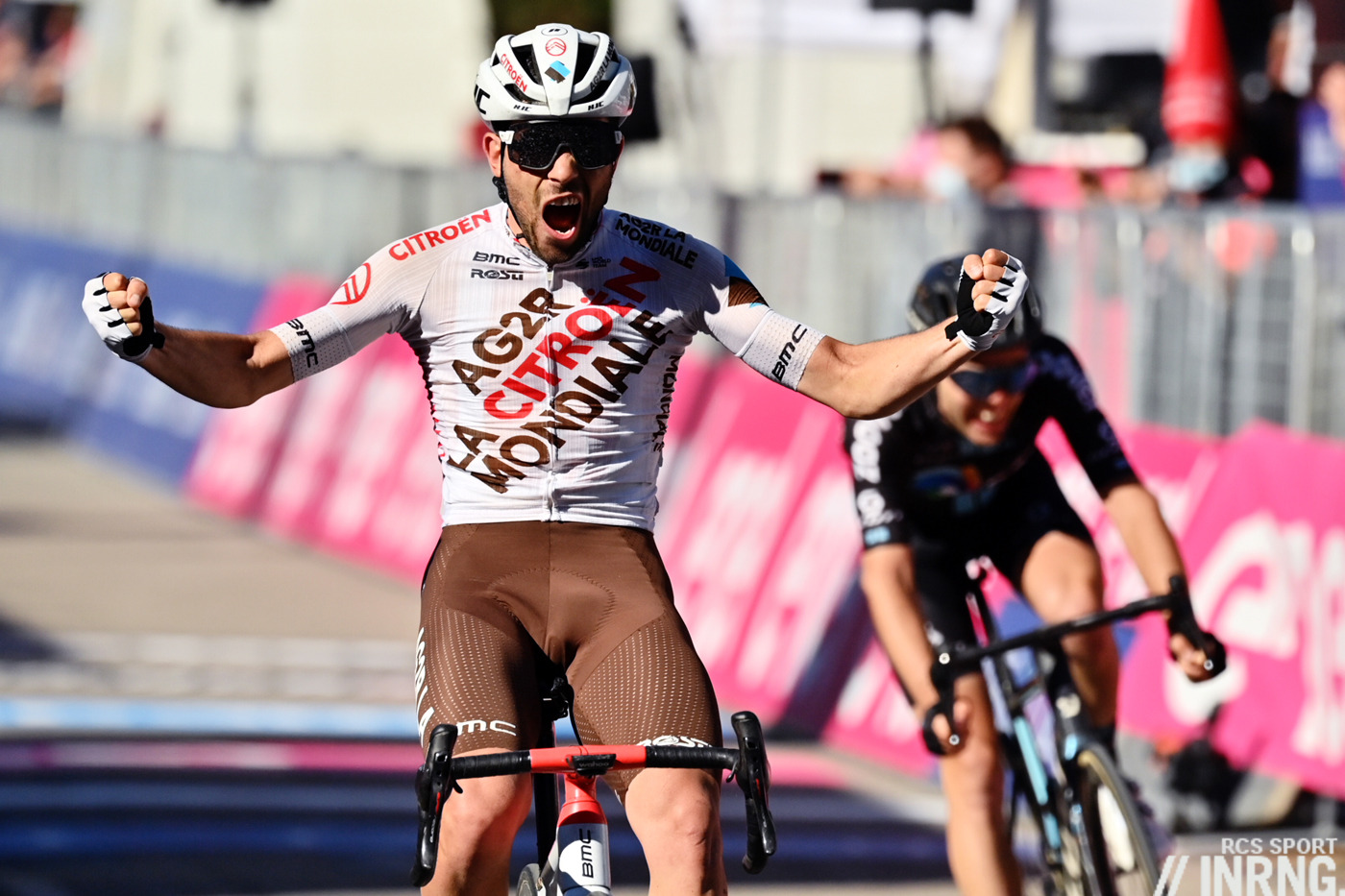
The following day’s stage to Bagni di Romagna was a case study of the Giro. To say the 2021 vintage rewarded the breakaways is to underplay it, to get in the day’s move was usually to have more than an option on the stage win, it was a ticket to contest it. So the problem was not to stay away for the day, it was to get in the break. Ineos would deploy Filippo Ganna and Salvatore Puccio on the front of the peloton and as long as the riders up the road weren’t a threat on GC to them or others then the move got a ticket to ride but often only after waves of attacks. This made for a lively first hour but once the move was gone, the peloton would ease up. It’s the opposite of last year’s Tour de France where Jumbo-Visma deployed Tony Martin to set a tempo that saw many breakaways crushed, much to the whispered annoyance of some teams. On the day Geoffrey Bouchard did plenty to make the mountains jersey his own and in the finish Andrea Vendrame won a crafty finish as the Giro rivalled the 2016 Vuelta for the number of new names winning grand tour stages.
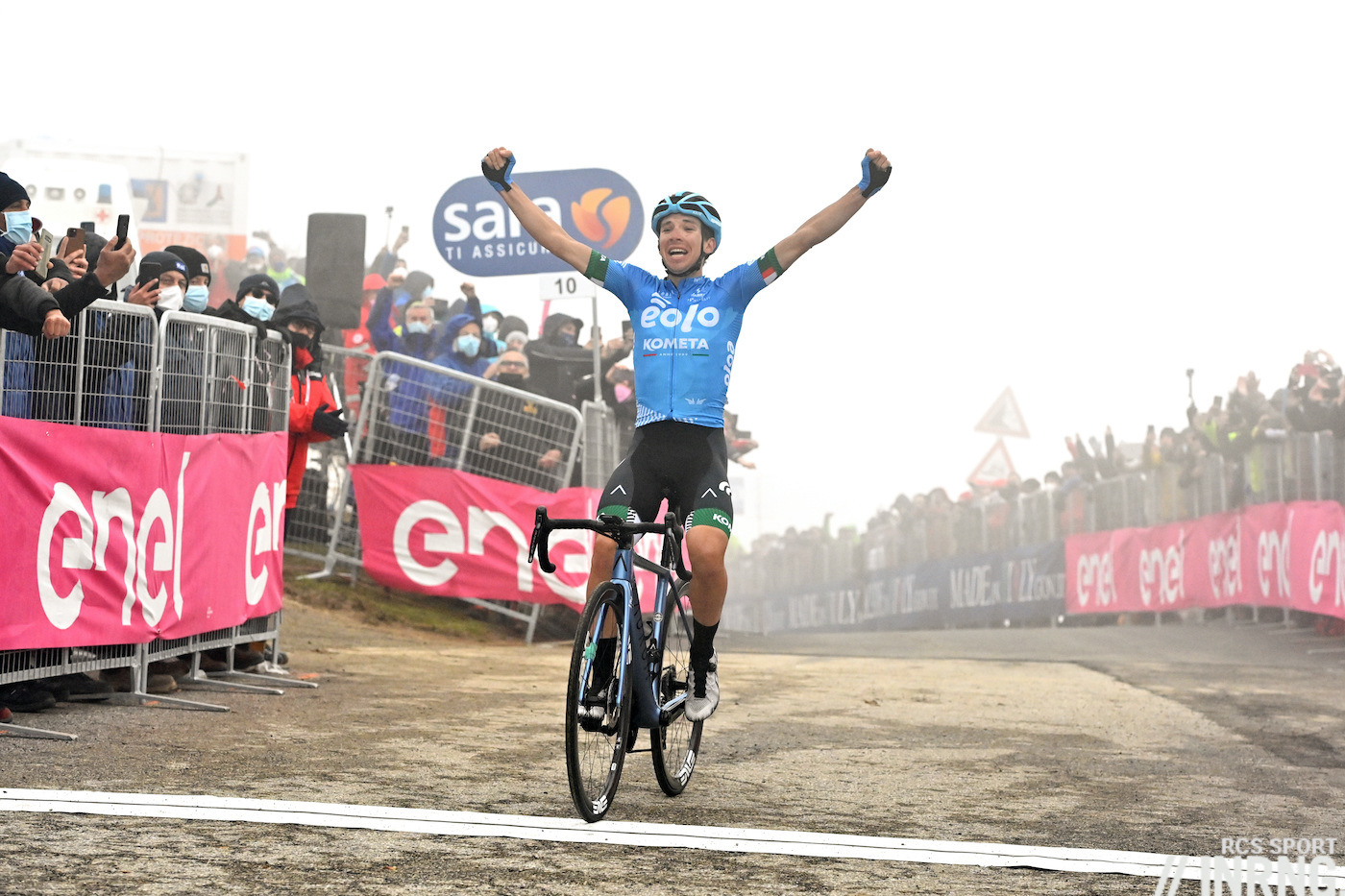
The Zoncolan came but via the easier eastern side, a clever ruse as the brand name alone spikes interest but without provoking such big time gaps. Still this was the first Alpine stage and behind Lorenzo Fortunato’s surprise win, Egan Bernal again took more time. As the chart below shows, every GC contender was losing ground to the Colombian and come Stage 14 and the Zoncolan everyone fell away.
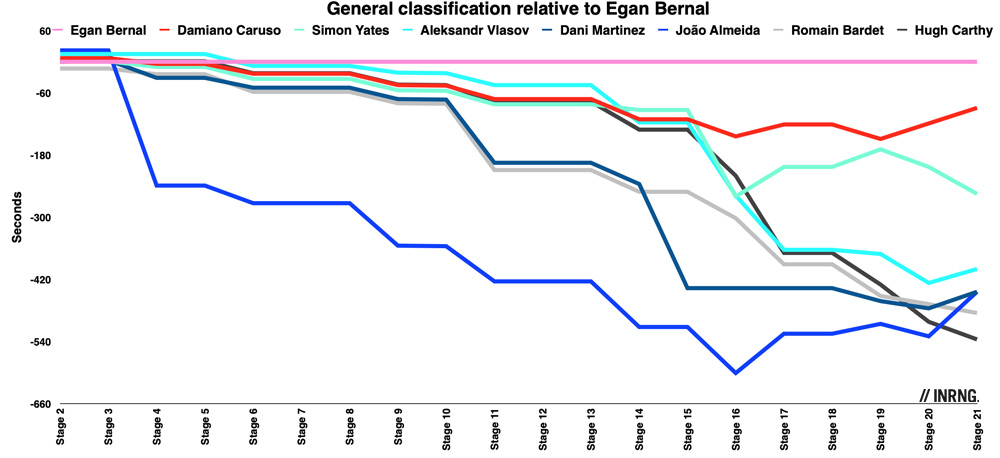
After a fun stage to Slovenia – almost the new Yorkshire with the crowds – with another breakaway and the GC riders huddling, we came to the tappone, the big day in the Dolomites. Only it was shortened at the last minute apparently as the change the route mid-way in case of snow would be even more awkward. True but to introduce an Italian word, this was dietrologia, that there was more to the story than the official version. There’d been an inscrutable rider protest, no rider wanted to say aloud they wanted an abbreviated course but that was what they got, even without the UCI’s Extreme Weather Protocol being used. And behind comes other things such as a rider union keen to prove itself as the peloton’s voice although sampling phone messages from riders on the eve of the stage leaves many questions. Some will say it was just wet, the passes were rideable and that’s true, but the peloton gets a say these days and the sport isn’t worse off because of it. There just needs to be more planning and with time we’ll get precedents to establish what is on and off. Cycling might be softer today but society as a whole has got much, much softer. The former is often derided while the latter is progress. Still cycling’s unique selling point though is the rider as Hercules or Maciste, heroes doing things others cannot and it can’t compete as a speed contest with MotoGP or Formula 1 so striking the balance is crucial to the sport’s future direction.
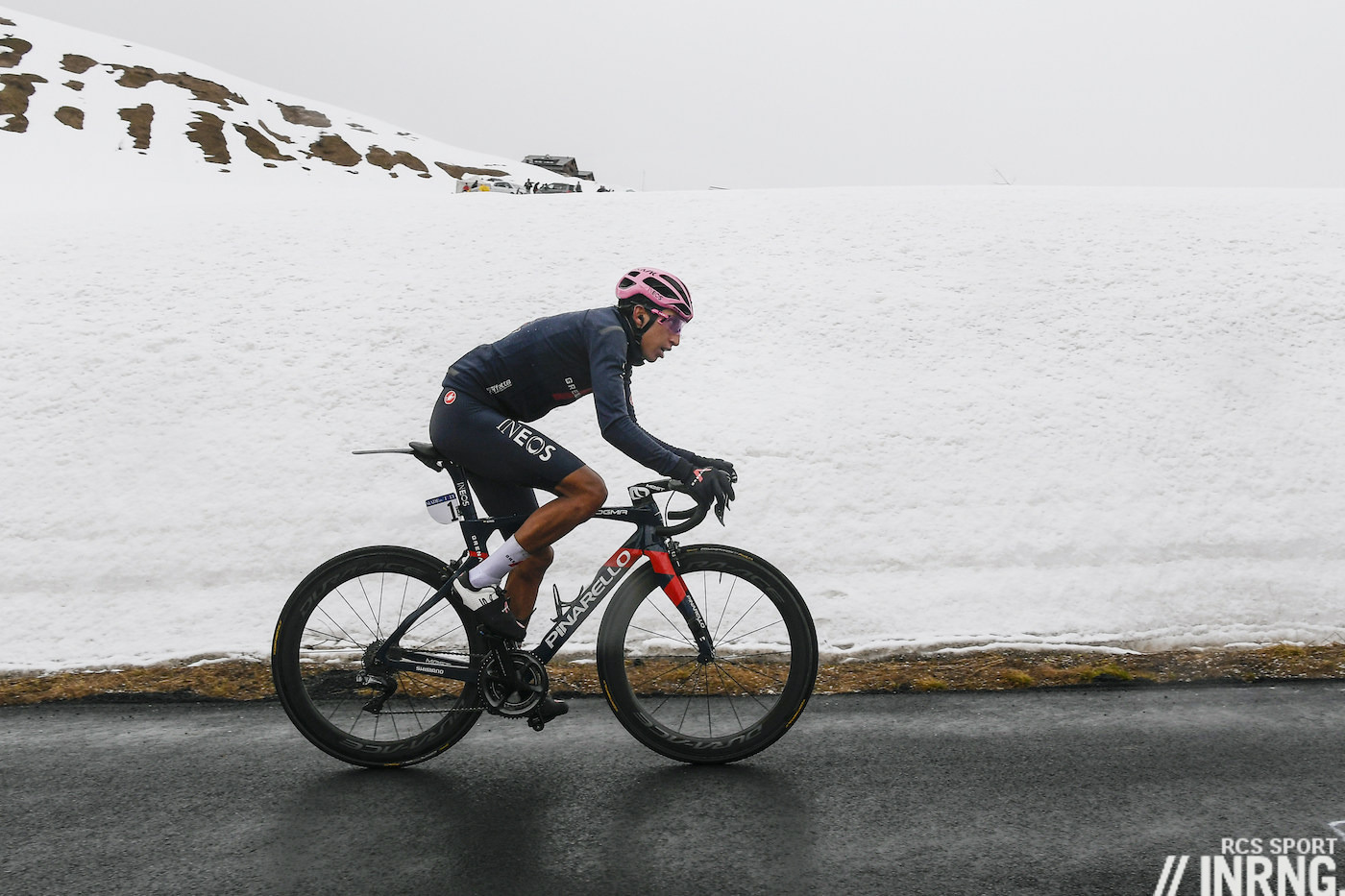
Egan Bernal did plenty to silence any post-stage polemica. This was compounded by host broadcaster RAI again dropping the coverage so many were grateful to get brief images from the Passo Giau, they couldn’t tell if the riders or the weather had nixed the Gavia and Pordoi. Bernal won the stage with time to spare, peeling off his rain jacket to show the maglia rosa and if he took is a relative newcomer to road cycling, his time in Italy seems to have given him not just the Italian language but a window into road cycling’s culture. It was a bit of theatre and he could afford it, by now the unheralded Damiano Caruso was in second place overall but two and half minutes down and obviously delighted with this. The Sicilian almost needed mirrors on his bike as he needn’t worry about Bernal, it was those behind him like Carthy, Vlasov and Yates that threatened his podium place.
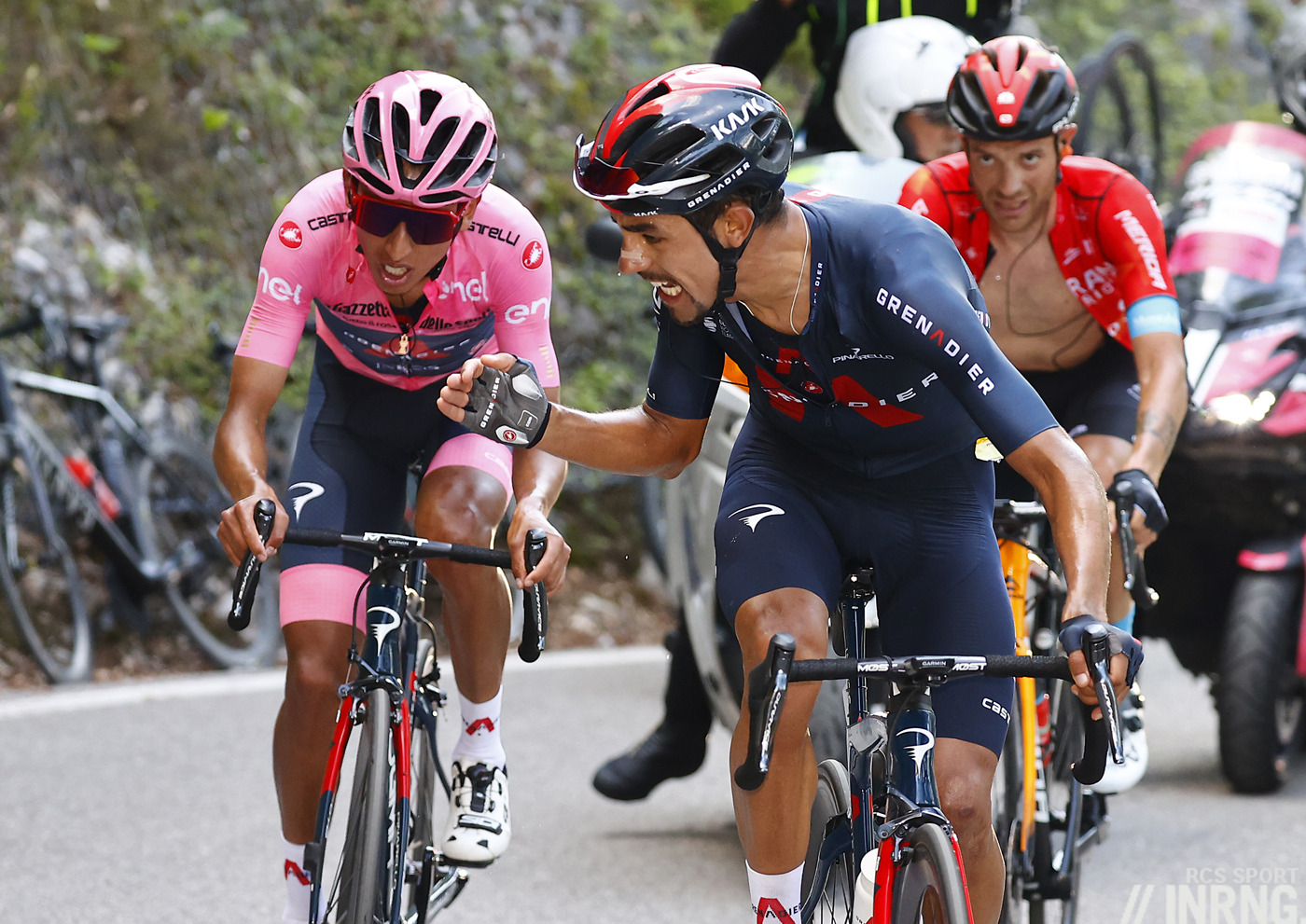
After a rest day the Sega di Ala finish on the Passo Fittanze saw Bernal for once in trouble, Simon Yates attacked once and Bernal followed, Yates went again and Bernal was stuck, as Dani Martinez cajoled him, a signing so vital that Ineos appeared to have bought him out of his contract with EF. But with over four minutes to spare on Yates Bernal didn’t have to panic. Still this helped enliven the racing, what if Bernal was on the slide, his back going into spasm? Dan Martin won the stage with a very fast ascent, one of the rare times the breakaway was constantly harried by the chasers in the finale and, along with the Montalcino gravel stage, it was one of the best days of the race.
The Alpe di Mera was where Bernal could start to think about where to place the Trofeo Senze Fine in his Monaco apartment because Simon Yates won but only by a few seconds, with João Almeida now making a remontada. After being iced by the rain on the stage to Sestola, then working for Evenepoel on the Montalcino stage Almeida was beginning to rise up the GC again. Only this was more because others like Bardet, Vlasov and Carthy were losing ground, Almeida’s gains on Bernal were more modest. Still he’s younger than Bernal, is superior in a time trial and might be back as a team leader next year once he’s got his kitchen refurbished with a new cooker extractor and some taps.
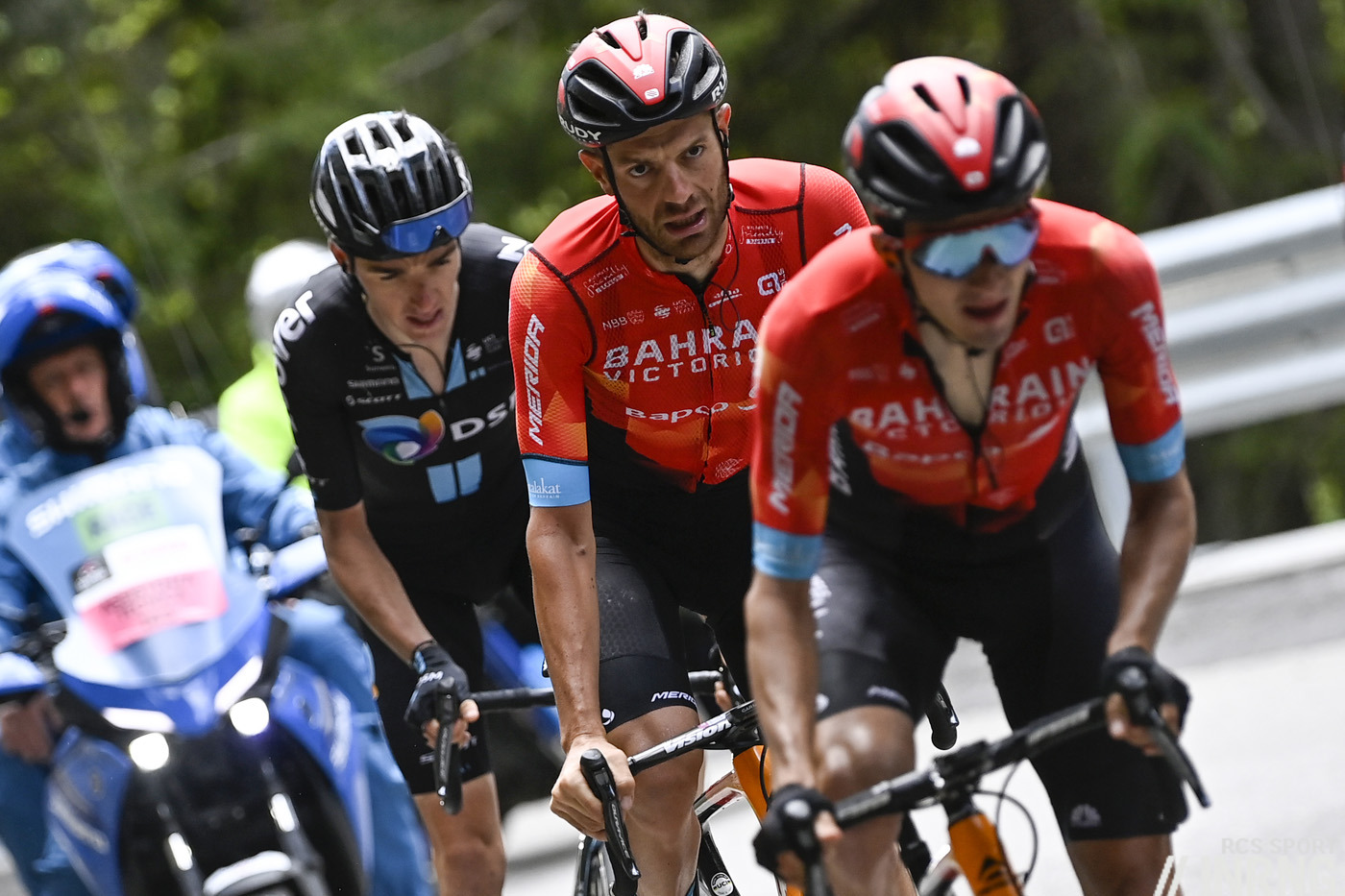
Damiano Caruso’s always been around, he’d made headlines for the wrong reasons to start with, then he’d been in the top-10 of grand tours several times and can match the best riders on the climbs which is why he’s been a premium helper for others all his career in the service of Vicenzo Nibali, Richie Porte and Mikel Landa. Still his rise up the rankings was even a surprise to him, when Landa crashed out Caruso joked he could target the Strava KoM on the Forca Caruso during Stage 9. He went for a lot more thanks to steady riding, until the Passo San Bernardino where he saw Team DSM launching a move down the descent for Romain Bardet and jumped on it out of instinct. He could have sat tight but gambled and got the stage win that transformed his Giro.
All that was left was the time trial in Milan and Filippo Ganna took a second stage win, neither towing the peloton for weeks, nor a puncture in Milan could stop him.
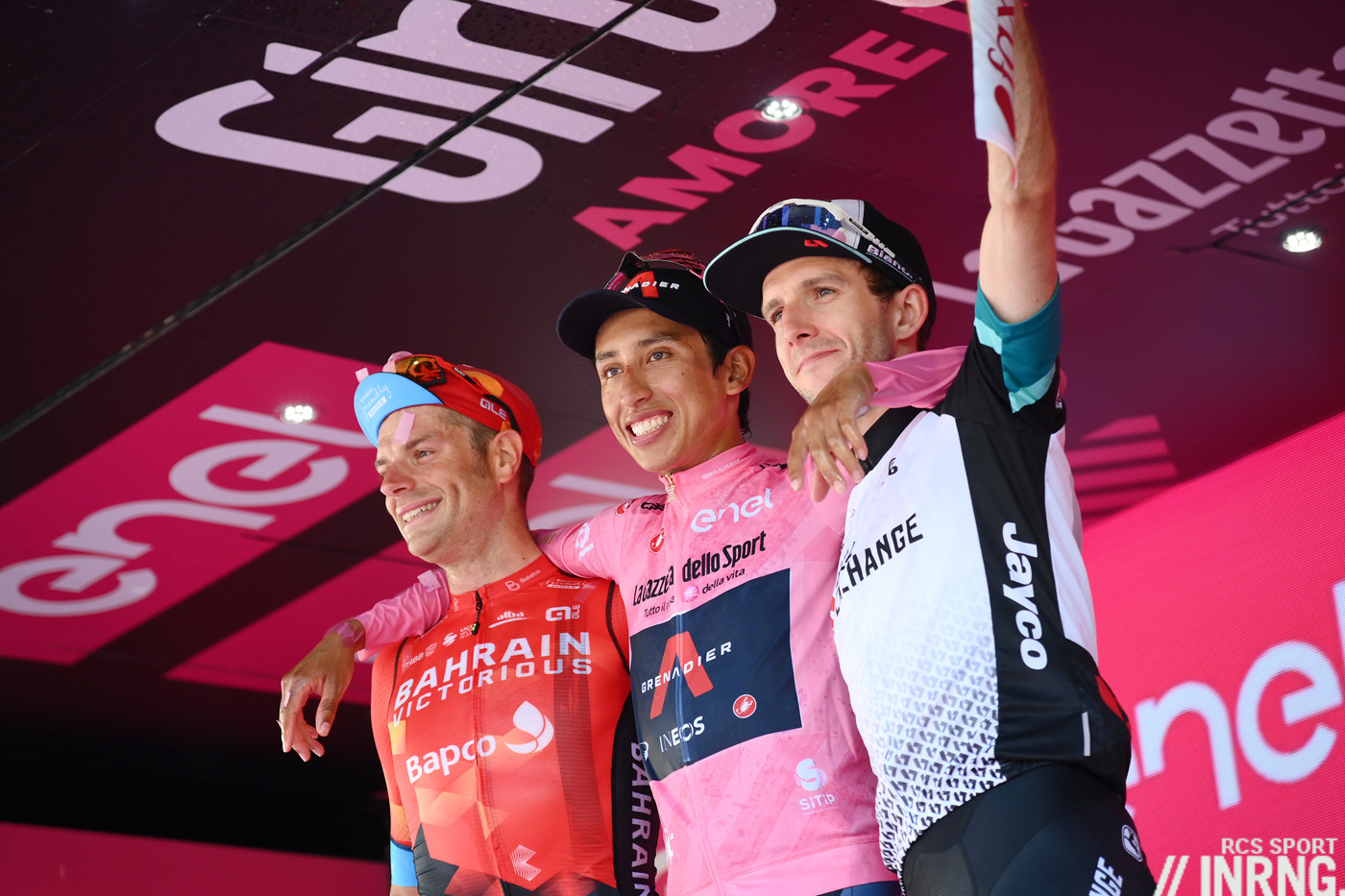
The Verdict
Back in May and all the better for it. If it often rained, this Giro still looked brighter than last October’s version thanks to the verdant vegetation, and felt cheerier too as Italy reopens. It was enjoyable edition although this Giro was more a collection of short stories than a novel for the ages. Billed to commemorate Dante, the racing was more Italo Calvino with daily episodes of the worker triumphing, starting with Taco van der Hoorn and finishing with Damiano Caruso on the podium. Each day’s stage was interesting thanks to open tactics and an engaging route but the three weeks lacked a genuine contest for overall classification. Ganna, De Marchi and Valter all did well but were clothes horses for Egan Bernal who took the maglia rosa and then kept on adding to his lead as many others fell away, helped by a strong team. Although not the steamroller of the Sky days, and Simon Yates was able to put on a late challenge, although he never recovered from losses and a problem in the first week he didn’t want to expand on.
It’s a big win for Bernal who is back to his best and as thoughts inevitably turn to the Tour de France, the 2022 edition feels almost more exciting already if we imagine Bernal and Tadej Pogačar and a cast of others.

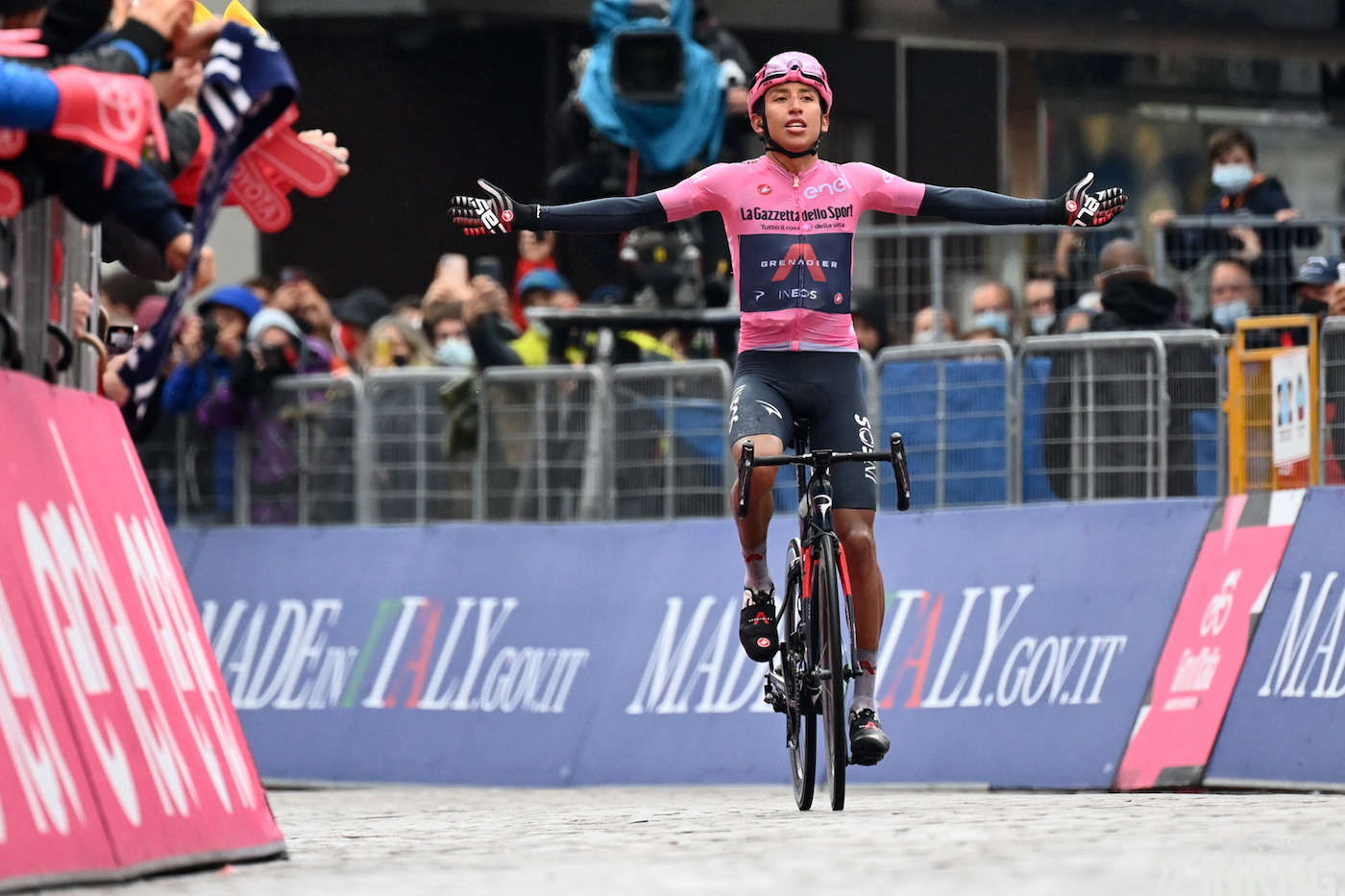
Thanks for the in depth analysis and review…..
For me, somewhat counter intuitively, the day the race was one was the one in which Bernal
‘cracked’…the fact that Bernal’s bad day was shown to be better than most rider’s best day
I thought Egan Bernal’s post race comments about how he had struggled after his TdF win were illuminating. Not only as they help explain the nerves & defensive riding in the last week but maybe offer a pointer for July when a different young rider will be defending their title.
I thought the Ineos team performed much better than I had anticipated. Pippo Ganna is arguably the best rider around at the moment. Gianni Moscon was much better than in the recent past, difficult to get past some of his previous behaviour though maybe he can fulfil his talent. Dani Martinez seems to have a future as a GT winner, he really performed in the last week and he is a competent TT rider. The other were good too especially as they lost Pavel Sivakov early on.
It will be interesting to see if Damiano Caruso will ride for GC in the future. A great result from an overlooked rider, I suspect he will be happy to go back to being one of the supporting cast rather than the star performer.
Patrick Lefevere seems to have a challenge on his hands with DQS. The decision to go with Remco Evenepoel as co leader was clearly misconceived perhaps betraying the needs of the sponsors over both that of the team and the rider. Having fantastic “numbers” is one thing but it needs to be allied with instinctive racing nous which is generally learned by endless hours on a bike from early childhood. It was actually a reasonable ride for a first GT especially after all the time off, the hype thing really cant help (see both Egan Bernal’s comments and from a different sport the issues with Noami Osaka).
Not a classic edition of the race, I still feel the Giro needs the high mountains to complete the narrative. No need for the sort of borderline heroics of 1988 on the Gavia but the sort of images we saw en route to the Stelvio last year are one of the things that make the race special.
As ever grazie mille for the best cycling site around.
As you and IR say, Evenepoel seems to have the watts and self-confidence in that power without the skills. Maybe if he can get in front that doesn’t matter, but in the peloton it’s crucial. If he ever wants to win Paris – Roubaix or Strade Bianche, maybe a temporary cooling of the road ambitions and a part-season of cyclo-cross or MTB would help. It’s in the Belgian culture.
And thanks for a great Giro Mr IR.
It’s interesting to note the difference in approach between Sky/Ineos with Bernal and DQS with Evenepoel when it came time to introduce them to Grand tour riding. Using Bernal as a domestic deluxe the year that Thomas won must have been beneficial to his development and understanding of the requirements and pressures around Grand Tour leadership. Given the hype and sponsorship priorities faced by DQS, that was probably never on the cards for Remco, but imagine if he’d gone into this Giro as Almeida’s wingman. I know – hindsight is a wonderful thing…
What a thoroughly enjoyable race with much to admire – not least IR’s deft navigation between the cliffs and whirlpools of prejudice and polemic. Long may it last, an island of sanity and balance in a world that seems increasingly detached from reality.
Many thanks to the host for the excellent analysis and to all for the lively commentary.
It feels like a Giro that was fairly one paced – that set by Bernal and his team – but was brilliantly illuminated by many special moments: all the first time winners, van der Hoorn staying away, Bernal sticking it in the big ring, Ganna launching on the sterrato, Forunato’s victory and his smile, Bernal riding away from the field and TV coverage and appearing in pink at the bottom embodying the Giro itself, Caruso, Bernal’s victory press conference. A lot to enjoy in this race.
+1
he’s got his kitchen refurbished with a new cooker extractor – Almeida to Bora??
A good Giro – sometimes TV-prod. was a little poor – not only the etapone – but also some early sprint finishes.
I enjoyed to see Bernal back –
Yes, the RAI broadcast has production issues as in the basics like the signal. But also problems with direction where the cameras struggled with the speed of a bunch sprint – Ewan’s first win was almost missed – or long shots of the peloton behind the breakaway when absolutely nothing was happening behind but the breakaway was an attackfest.
They hardly recovered from the shift in the commander’s seat some seasons ago, but this year was quite poor. Or was it a subtle nod to the Vueltish nature of this Giro? 😛
Spanish TV production of cycling isn’t the best. But this year’s Giro was unspeakably bad, directed by somebody who seemed to want to give the impression of not understanding even the basics of a bike race. It would have shamed a country entirely new to World Tour cycling never mind a country with the rich history, tradition and fan base that is Italy.
I’ve long watched both and this year’s Giro was actually on par with some *classic* Vueltas (not to speak of Catalunya, which even does worse, but it’s also a much smaller race). Not a compliment for either.
“one day a prince, the next a worker.” I thought you were going to write, “one day a prince, the next day a pauper.” Ganna is the new Tony Martin and perhaps in the future Cancellara.
The other addition to this edition was Chris Horner’s daily youtube recaps giving the veteran pro’s view of each stage. Refreshing to see him calling out “knucklehead” moves when teams put riders in front of the peloton, taking the load unnecessarily off Eneos.
Maybe you’ve written about it already (I’ll look for it) but we can only speculate what might have been for Almeida had he been given equal freedom and support as Evenepole, as the title “co-leader” would have afforded him. The commentator mentioned he was in his final year at DQS and unlikely to be re-signed. And if he was given the order to drop back from the leaders to escort Evenepole, he is undone in his own ambitions, and if he refuses (which is what it initially looked like) he is also undone, as who wants to sign a rider that doesn’t follow team orders?
It was always harder for Almeida, he’s leaving – and the idea that a rider who is leaving has practically left in terms of treatment needs reviewing as he’s there in the jersey, with the logos etc – but Evenepoel is Belgian, has signed a very long term contract etc so there was a big tilt to the younger rider. Unfair, or just business? We’ll see, even if we imagine for the mental exercise where Almeida had Evenepoel as a servant it might have got him to, say, 4th place overall. Nice but not game changing.
Thanks as always to our host for the wonderful education you provide to your readers.
dietrologia, I now have to add to my limited english lexicon.
Although he was slightly struggling again on stage 20, probably confirming some issue with high altitude and/or cold temperature, I’d say that Simon Yates can be included in the list of athletes who, despite what some trainers now say, were able to reach full form through the race and peak in the third week. For example, I don’t think that anyone could ever say that the w/kg he pushed on Alpe di Mera were good “only relative to the decline of others”. It was an absolute performance, and he surely wasn’t getting that good in previous stages.
As our host alluded ^^ it would be interesting to hear why the drop in form in the first half of the race (day in the cold notwithstanding).
Thanks for the brilliant write ups Inrng! W il Giro!
Hard to prove/disprove. First part of Yate’s race was compromised. He would have worse numbers there.
*Very* hard to imagine that Simon Yates could ever produce peak numbers much better than those he pushed on Alpe di Mera, around 6.5 w/kg for half an hour, whenever in the race, or whatever his physical conditions. During the first week Yates couldn’t hold a pace of some 6.2 w/kg for a mere quarter of hour – and that’s what the best were pushing.
A very good edition of the Giro while not close in the finish, still entertaining with plenty of sub-plots. However, the insights from Inrng make it all the more enjoyable. Thanks again for you daily previews and analysis of the previous stages.
You guys are so great. I stay up past my bedtime here in California waiting for your previews to come out (is there any way you can get them out an hour or so earlier?) ;-).
As for this year’s Giro, my favorite stages were: Stage 3 “Taco Monday”, Stage 6 “Gino’s Revenge” (glad Roglic wasn’t there), and Stage 18 “Bettiol vs Cavagna”. Drama and intrigue galore.
Thanks for all that you do!
Great coverage throughout — thanks for all of it
Great write up, thanks for all the coverage.
Small correction, “The Alpe di Mera was were Bernal”: were -> where
Please feel free to delete this comment!
Minor point of pedantry – “the last time Ineos/Sky lost the GC lead in a grand tour…was” surely when Ganna lost it in this Giro?
“Billed to commemorate Dante, the racing was more Italo Calvino with daily episodes of the worker triumphing,” – Funny and insightful. Excellent writing. Thank you.
Cycling and society softer, you say?
How many days racing do current pros get, against the days of yore*?
How many days at average salary does it take to buy a house or pay the rent?
* where yore = the few days of racing that have archive photos necessary to prove a point about grinta in t’olden days.
Here’s a +1 to the other comments here – wonderful race, really only marred by some dodgy coverage, with lots of satisfying and inspiring winners and plenty of entertainment every day, all masterfully augmented by the insights and fine writing by our host. And lots of generally excellent comments and discussion. Thanks to everyone: Inring, riders, race organizers, and fellow peanut gallery members.
As Kevin K said ¨Thanks to everyone: Inring, riders, race organizers, and fellow peanut gallery members
There is no doubt Bernal is a great racer. However, I would like to see him winning a race with no shortcuts. Either a landslide or bad weather or cable car accident but his GT have not been 100 % .
My two great moments of the Giro: 1. Caruso´s thanks to Pello and 2. Fortunate´s triumphal salute on the streets of Bologna.
True and heartfully agreed re: Bernal, yet let me say “fra il serio e il faceto” that anyway this Giro’s course had more serious stuff in it, even after the cuts, than most Tours and pretty much any Vuelta.
(Luckily enough, truth must be said, the routes got better in France and in Spain, too, especially in very recent years)
You seem absolutely convinced that Almeida is going to Bora, or indeed has already signed for them. There was a suggestion on UK Eurosport from Brian Smith that Ineos were interested though. I hope for the sake of a bit of variety that you are correct. I presume you are because being Portuguese he wont have been born and raised at sufficient altitude to pass the Ineos entrance tests.
Let’s say the truth: softened cycling IS worse-off. Of course. It is less impressive, less inspiring and less attractive. It generates less empathy with the rider and has much less emotional value. Facts are facts. The overall effort and hardship endurance requireded to complete a GT should at least remain constant across the decades, and oganizers should be completely free to design the race they see fit.
“Tonight, Matthew, I am going to be Henri Desgrange.”
Funny. Our Ferdi does have a point though, its the inspiring feats we all come to see. And, if distance, difficulty, the weather etc hold no interest or aren’t valued anymore then we may as well just watch track cycling.
+1 Anyone wanting any more from me can go here: http://cycleitalia.blogspot.com/2021/05/giro-ditalia-2021-final-thoughts.html
Races are much harder in 2021 than in 1990’s and 2000’s. If you don’t have EPO much harder to recover in between stages, therefore the next day is harder. Distances are staying the same and it takes longer to establish a break.
Please, someone who makes this comment take your bicycle and go ride for 4 hours today, then ride 4 hours tomorrow… see what it feels like.
If you don’t have EPO.
(nor anything equally *opportune*)
Ketones have markedly changed racing and recovery for (some) riders, that’s before even starting to guess about more unknown/illegal practices.
I don’t understand your point. What ‘facts’ are you referring to? Is it about the stage that was shortened, or the race in general?
If the former, then I agree that once the stage has been fixed by the organisers and the teams signed up, it shouldn’t be changed except for genuine safety reasons, and I don’t think that this was an example of that.
If the latter, then I disagree. Who wants to go back to 400km stages starting at 4am? Not me, anyway.
Ferdi believes all the old myths, despite the fact that they’ve long been disproved by great writers such as Graham Robb and Benjo Maso. His choice (or fetish), of course, but I prefer to believe what I see with my own eyes. Even dopers actually ride all the way
I wouldn’t dare say – on the basis of one comment that can be interpreted in different ways, including some that aren’t quite what the commenter had in mind – what Ferdi believes. But thanks for bringing Benjo Maso to my attention.
https://www.podiumcafe.com/2010/9/15/1637195/interview-benjo-maso
I hadn’t seen that before. It’s great. Bartali in ‘48 has been covered very often in social and sporting histories- John Foot is good on it too- but I’d love to read Maso too.
This Benjo Maso link is also gold, indeed. Quite much well informed!
haha, exactly. I have no clue what Ferdi is referring to. This Giro looked incredibly hard. The stages were intense, Bernal’s victory was not really safe at any point until the TT, and the challengers were really strong riders in peak condition. Some beautiful stages that were also brutal to complete thrown in and you have a great race.
Inrng already proved that the “shortened” stage was still brutal – it was much longer than the “hardest stage in history” which sent Andy Hamsten to legend status.
“it was much longer than the ‘hardest stage in history’ which sent Andy Hamsten to legend status”. Pffff… this is a bit silly! Tongue in cheek, I guess?
without any evidence to back it up I suspect that GT’s are raced harder these days than 20-30+yrs ago… a lack of Hinault/Cipolini style patrons controlling the first week or two, and a general uplift in the overall standards of the peleton (due to improved training methods/nutrition/recovery/fancy buses etc) plus less drugs (hopefully?).
Having said that I do feel sorry for the well prepared hard men who could prosper in a really tough stage, who have that taken away from them so the thoroughbreds get looked after… I suppose we’d all rather watch racehorses than carthorses do their stuff though…
The TdF had its capos with a crush for slow cruising in recent years, too… 😉
Anyway, 20-30 years ago were the 90s, when, for example, the Tour was raced *way* harder than these days. It often averaged some 39,5 km/h with a way longer route and with much more altitude gain. The last 2-3 years are when we’re seeing notable speeds on courses which albeit not as hard as in the past, are by no means as easy as, say, 2012 (which was also relatively slow). However 2012-2017 was a period of “easier” routes which had both fast editions (2013, 2014, 2017) and quite slow ones (2012, 2015, 2016). We often saw soft racing, sometimes in the form of fast plains and slow mountains – sometimes just soft racing all around.
I couldn’t say about the 80s, but you should also consider that the whole strategy was different, you saw much more often the best riders riding deep in a stage with no team support, or attacking from far and so on, which makes for way harder racing, for the top guys at least, although you don’t see exceptional average speeds in the final results, precisely because they didn’t have gregari pacing them around the Alps. Maybe it was an easier life for the support riders, indeed. But probably it also depended on a more varied athletic level in the peloton, a little like what we see in women cycling now… which means that many secundary figures maybe had to struggle much just in order to get through the stages.
The Giro is a whole different story. In the 90s it often had harder courses than the Tour’s (and the Tour had some hell of a route quite often!), which partly explains a lower average speed. But there was also that “Cipollini effect”: ride easy until the TV helicopters appear. Then it got slightly easier course, and slower speeds because of a lower level. Finally, in the last 15 years or so, both difficulty and speeds went generally up. 2011 and 2016 were just impressive, hugely hard and fast. 2017 was notable, too (2018 was fast but easy; exceptions are to be found here and there, for example 2012 wasn’t that hard and yet was quite slow).
The Giro, in fact, mirrors quite well your impressions (with some exceptions here and there)… unlike the Tour.
The paradox is that we’re all supposedly softer yet world records are being smashed all over the place, and technological change is happening at a rate that our ancestors would’ve struggled to cope with. And population growth and vast differences in childhood opportunities means it’s getting increasingly difficult to be outstanding at something… the relative comfort that most of us enjoy is basically compensation for the fact that aspirations are less likely to be fulfilled in the 21st century than they were in the 20th.
Honestly I’d rather crash on a 1920s bike than a 21st century TT bike.
These measures should always be relative though.
For instance, ‘poverty’ measured 100 years ago was just that – no welfare state, minimal healthcare, poor accommodation with shared outside toilets, minimal education, very long working hours and a lack of worker’s rights etc.
Today, we refer to ‘relative poverty’ and the indices are different.
That’s as it should be, society should always strive to improve and push the barriers upwards.
The same is true of sport.
A race to the top, in more ways than one?
Uh, Ecky, I suspect you are not very familiar with poverty in some areas of present Europe, which looks actually quite similar to what you depict above. In fact, “relative poverty” isn’t being used that much anymore, rather a series of elements related to specific conditions of life.
Sadly you’re right no doubt, but al least there is some measurement to go by.
Cycling has never had or kept hard facts and figures, it prefers to get by via legends and tales, and that’s at the root of this problem I feel.
If figures were kept of accidents, and correlations with weather etc, you’d expect to see numbers go up when poor weather and fatigue are prevalent.
That would provide a base from which to improve safety and conditions.
I noted that there was a lot of comments on the shortened stage about the temperature at the top of the two cancelled climbs, but what about the sub-zero air temperature on the descents after the riders had been hosed with ice cold rain?
Risky, dangerous, exciting or epic?
Racing can become faster and safer, the two needn’t be mutually exclusive.
Numbers so often don’t go where you (or I, or anyone) would expect to. You’ve got my vote if you ask for more figures and stats, yet for now my wild guess is that accidents wouldn’t go rampant as you expect to (essentially, because of increased selection, be it by pure effort or thanks to several people just calling themselves off; which reduces density and mutual pressure within the peloton). Plus, I believe that such accidents could be less serious, for a series of different reasons (starting with reduced speed). However, as I said, it’s a wild guess, and it could be just as wrong as the opposite conjecture. Then, you need to draw a balance between that risk, once you’ve assessed it, and the added value of racing in a broad range of conditions.
That said, let me underline again that *nobody* on the field *ever* said, when the decision was taken, that *any* danger or health issue could be envisaged under those – real or forecast – weather conditions. Nor Vegni nor the riders nor the union nor the teams. In fact, the EWP could not be applied. Feel assured that they all know what wind chill is, and, given their interest to cut the stage, they’d have used any reasonable argument. Only, there was no one.
As always, thanks for the wonderful coverage.
“one day a prince, the next a worker” – I didn’t see this as an awkward sell for Ganna. Instead, it seemed to enhance his reputation. Not a cosseted superstar, but a team player willing to rip the legs off the rest of the peloton: a prime Tony Martin or WVA in last year’s Tour (albeit in a slightly different role). How was this worker role perceived in Italy?
More as I suggested, it was a harder sell to say “hail the champion” one day, then “he’s a gregario like Puccio” the next to the general public but this is only going by RAI, some Gazzetta and other newspaper articles, anecdotes rather than national polling.
Cheers – I was thinking of the Italian press when I wrote that, rather than true national mood. I guess there’s a tradition to “honour the jersey” regardless of whether you can keep it for the long term, so doing big pulls on the front is nowhere near as romantic, not least when you’re an Italian star.
Just to say that Marcovaldo is my favourite book ever.
Thanks, as always, for your daily coverage! Time goes by but this blog is still the best place for Cycling fans to read about races.
It was great to follow Giro from the Inner Ring blog as usual. I was wondering which moment you would pick as the moment race was won. I actually thought of the gravel stage which had some parallels with Le Tour in 2014, where Nibali was the big winner of the cobbled stage among the GC contenders. Both Bernal and Nibali were among the favorites in these two tours but there were still some question marks surrounding them for differing reasons. Both of them removed the question marks afterwards, while the other favorites mostly failed in the gravel and cobbled stages showing riding and winning grand tours is also about skill to avoid troubles apart form the high mountain stages.